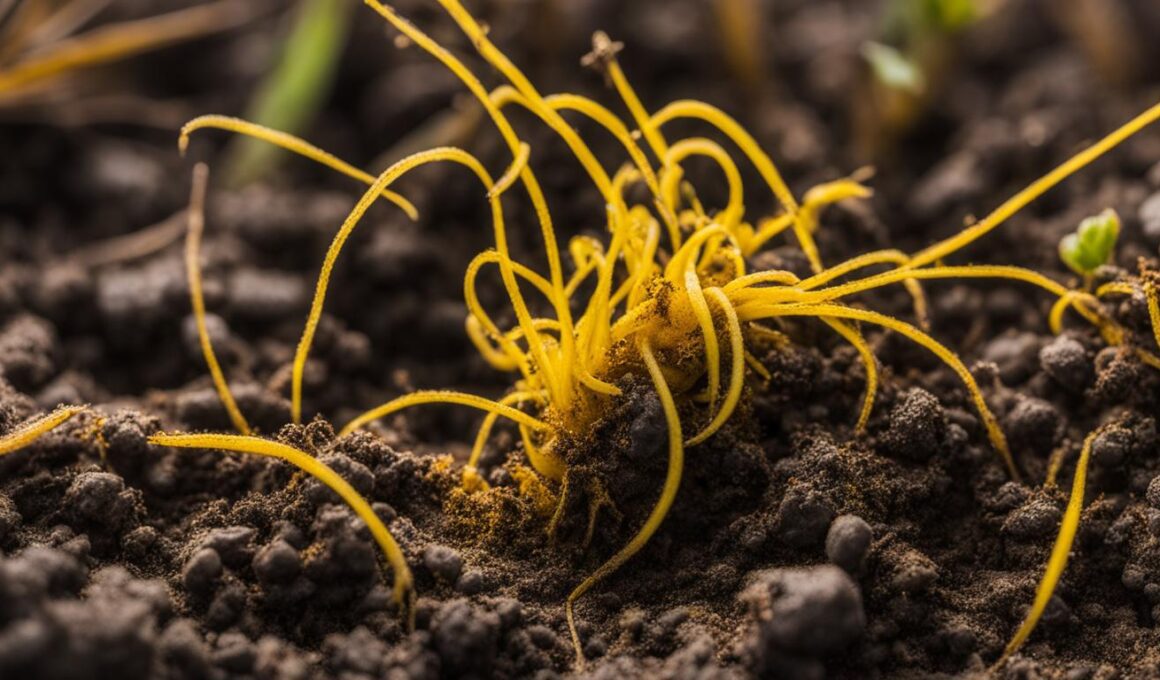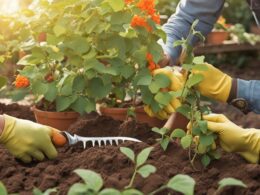Welcome to our informative guide on yellow mold in soil. If you’ve noticed yellow mold on the soil of your potted plants or in your garden, you might be wondering what causes it and how to get rid of it. In this section, we’ll explore the causes of yellow mold in soil, provide step-by-step instructions on how to remove it, and offer practical tips on preventing its reoccurrence. Let’s dive in!
Yellow mold in soil is typically caused by saprophytic fungi, which are harmless and even beneficial to most plant species. These fungi thrive on organic matter found in the top layer of soil, such as bark segments, sphagnum peat, or soil grains. While yellow mold may not pose a threat to your plants, many gardeners prefer to remove it for aesthetic reasons.
Removing yellow mold from soil is a straightforward process that can be done by following a few simple steps. We’ll walk you through the process in the next section, so stay tuned!
How to Remove Yellow Mold from Soil
Yellow mold in soil can be unsightly and bothersome for many gardeners. If you’ve noticed this mold in your plant’s soil, don’t worry! With a step-by-step guide, you can effectively remove the yellow mold and prevent its reoccurrence. Follow the instructions below:
- Inspect the Plant Roots: Take the plant out of its pot and carefully inspect the roots for any signs of root rot. This can be an indication of over-watering or poor drainage.
- Clean the Container: Wash the container or pot with warm soapy water or hydrogen peroxide to remove any ungerminated mold spores. This will help prevent further mold growth.
- Replace the Soil: Remove the top 25% or two inches of the infected soil and replace it with fresh potting mix. Be sure to remove any large lumps of organic matter that may harbor mold spores.
- Consider the Plant’s Location: Assess the location of the plant and make necessary adjustments. Avoid placing the plant in dark locations with poor air circulation, which can promote mold growth.
- Adjust Watering Habits: Over-watering can contribute to mold growth. Reduce the frequency of watering and allow the top few inches of soil to dry out between waterings.
- Check Compost Quality: Avoid using poorly stored compost or soil that may be contaminated with mold spores. Opt for fresh, well-composted materials.
- Monitor and Remove Mold: Regularly check the soil for signs of mold development. If you spot any moldy soil, remove it promptly to prevent further spread.
By following these steps, you can successfully remove yellow mold from your soil and create a healthier environment for your plants. Remember to address any underlying issues such as over-watering or poor drainage to prevent future mold growth.
Disclaimer: In some cases, it may be necessary to consult a professional horticulturist or plant expert for proper diagnosis and treatment of mold issues.
Preventing Yellow Mold in Soil
To prevent yellow mold in soil and ensure the health of your plants, it’s important to take proactive measures. Follow these tips to keep your soil free from mold:
- Water your plants correctly: Overwatering can create excess moisture in the soil, providing a favorable environment for mold growth. Allow the soil to dry out between waterings, ensuring it is slightly moist but not overly saturated.
- Ensure proper drainage: Good drainage is essential in preventing moisture buildup. Use pots with adequate drainage holes, allowing excess water to escape and preventing waterlogged soil. Avoid pots that impede proper drainage.
- Promote air circulation: Adequate air circulation is crucial for preventing mold growth. Avoid crowding your plants, as this can create a humid environment that promotes mold development. Give your plants enough space to breathe and grow freely.
- Choose a well-draining soil: Opt for a high-quality soil mix that provides good drainage. This will help prevent excess moisture accumulation in the soil, reducing the risk of mold growth. Avoid using compacted or heavy soils that retain water for extended periods.
- Add natural antifungal agents: Consider incorporating natural antifungal products into your soil, such as cinnamon, apple cider vinegar, or baking soda. These can help inhibit mold growth and protect your plants from fungal infections.
- Remove infected plants promptly: If you notice any signs of yellow mold or fungal infection in your plants, take immediate action. Remove the infected plants from your garden or indoor space, ensuring that mold spores do not spread to other plants. Properly dispose of the infected plants to prevent further contamination.
- Consider using hydrogen peroxide: Hydrogen peroxide can be an effective tool to kill fungus in plant soils. Dilute hydrogen peroxide in water (1 part peroxide to 4 parts water) and use it to irrigate the soil. This can help eliminate mold spores and prevent mold growth.
By implementing these preventive measures, you can maintain a healthy growing environment for your plants and prevent yellow mold from taking hold in your soil. Regular monitoring and proper care will go a long way in keeping your plants thriving and mold-free.
How Does Yellow Mold in Soil Affect the Health of my Peace Lily Plant?
Yellow mold in soil can have a detrimental impact on the health of your peace lily plant. If you notice your peace lily turning yellow, it could be a sign of mold affecting its roots. Mold can block essential nutrients and water from reaching the plant, causing it to wilt and eventually die.
Will Cutting Off Lupin Seed Heads Help Prevent Yellow Mold in Soil?
Cutting lupin seed heads may help prevent yellow mold in soil. By removing the seed heads, you can reduce the chances of mold spreading and causing issues in the soil. This practice can help maintain the overall health of the soil and prevent potential problems with yellow mold.










